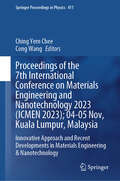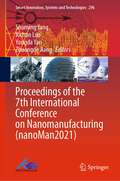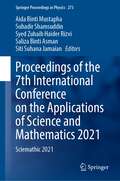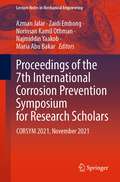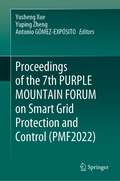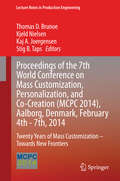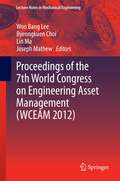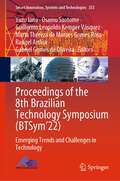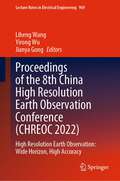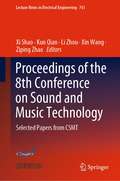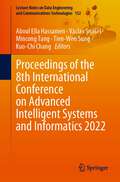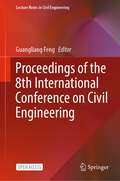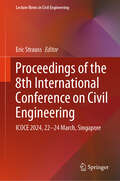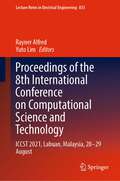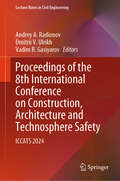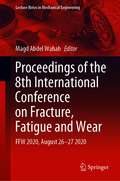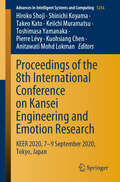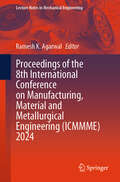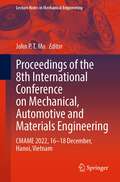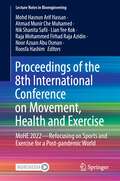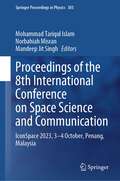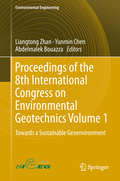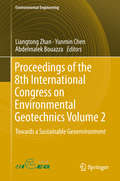- Table View
- List View
Proceedings of the 7th International Conference on Materials Engineering and Nanotechnology 2023: Innovative Approach and Recent Developments in Materials Engineering & Nanotechnology (Springer Proceedings in Physics #1068)
by Cong Wang Ching Yern CheeThis book includes selected peer reviewed articles presented at the 7th International Conference on Materials Engineering and Nanotechnology 2023 (ICMEN 2023) held on 04-05Nov at Kuala Lumpur in Malaysia. It highlights recent innovative approach and developments in materials engineering and nanotechnology fields. A broad range of topics and issues in modern materials science and nanotechnology are discussed, including advanced materials synthesis and characterization, nanoscale science and engineering, functional composite and nanomaterials, sustainable materials and green technologies. The importance and relevance of these proceedings lie in their contribution to the scientific community's collective knowledge and understanding of materials science/engineering and nanotechnology. By disseminating cutting-edge research findings and innovations, these proceedings foster collaboration, inspire new ideas, and push the boundaries of scientific discovery. Given its scope, this book will be of interest to a wide readership, including materials and nanotechnology engineers, scholars and researchers in science, technology and engineering disciplines.
Proceedings of the 7th International Conference on Nanomanufacturing (Smart Innovation, Systems and Technologies #296)
by Zhuangde Jiang Shuming Yang Xichun Luo Yongda YanThis book is a compilation of selected papers from the 7th International Conference on Nanomanufacturing (nanoMan2021), held in Xi’an on November 17-19, 2021 after postponing twice due to COVID-19 pandemic. It encompasses the synthesis of nanomaterials, the fabrication of devices, the characterization of various products and systems, process monitoring and quality control, simulations, and the applications of nanoscience and nanotechnologies.
Proceedings of the 7th International Conference on the Applications of Science and Mathematics 2021: Sciemathic 2021 (Springer Proceedings in Physics #273)
by Aida Binti Mustapha Suhadir Shamsuddin Syed Zuhaib Haider Rizvi Saliza Binti Asman Siti Suhana JamaianThis book presents peer-reviewed articles and recent advances on the potential applications of Science and Mathematics for future technologies, from the 7th International Conference on the Applications of Science and Mathematics (SCIEMATHIC 2021), held in Malaysia. It provides an insight about the leading trends in sustainable Science and Technology. The world is looking for sustainable solutions to problems more than ever. The synergistic approach of mathematicians, scientists and engineers has undeniable importance for future technologies. With this viewpoint, SCIEMATHIC 2021 has the theme “Quest for Sustainable Science and Mathematics for Future Technologies”. The conference brings together physicists, mathematicians, statisticians and data scientists, providing a platform to find sustainable solutions to major problems around us. The works presented here are suitable for professionals and researchers globally in making the world a better and sustainable place.
Proceedings of the 7th International Corrosion Prevention Symposium for Research Scholars: CORSYM 2021, November 2021 (Lecture Notes in Mechanical Engineering)
by Azman Jalar Zaidi Embong Norinsan Kamil Othman Najmiddin Yaakob Maria Abu BakarThis book gathers the latest research, innovations, and applications in the field of corrosion prevention and control, as presented by leading national and international academics, researchers, engineers, and postgraduate students at the AWAM International Conference on Civil Engineering 2022 (AICCE’22), held 7th International Corrosion Prevention Symposium for Research Scholars (CORSYM 2021), held as a virtual conference on November 2021. The CORSYM 2021 theme, Nurturing Future Corrosionist for Better Corrosion Mitigation, covered key topics such as corrosion and inhibitors, corrosion of biomaterials, top of line corrosion, H2S and CO2 corrosion, coatings and composites for biomedical devices, electrochemical testing techniques, advanced materials and coatings, corrosion in concrete structures, welding and hot Corrosion, corrosion in ships and marine structures, corrosion of biomaterials, corrosion Under insulation, digitalization in corrosion. The contributions introduce numerous exciting ideas that spur novel research directions and foster multidisciplinary collaborations between various specialists in the field of corrosion engineering.
Proceedings of the 7th PURPLE MOUNTAIN FORUM on Smart Grid Protection and Control (PMF2022)
by Yusheng Xue Yuping Zheng Antonio Gómez-ExpósitoThis book includes original, peer-reviewed research papers from the 7th PURPLE MOUNTAIN FORUM on Smart Grid Protection and Control(PMF2022), held in Nanjing, China, on August 14-15, 2022. The accepted papers cover the following topics: 1. Advanced power transmission technology2. AC/DC hybrid power grid technology3. Power Internet of Things Technology and Application4. Operation, control and protection of smart grid5. Active distribution network technology6. Power electronic technology and application7. New technology of substation automation8. Energy storage technology and application9. Application of new technologies such as artificial intelligence, blockchain, and big data10. Application of Information and Communication Technology11. Low-carbon energy planning and security12. Low-carbon operation of the power system13. Low-carbon energy comprehensive utilization technology14. Carbon trading and power market15. Carbon emission stream and carbon capture technology16. Energy saving and smart energy technology17. Analysis and evaluation of low-carbon efficiency of power system18. Carbon flow modelling in power system operationThe papers included in this proceeding share the latest research results and practical application examples on the methodologies and algorithms in these areas, which makes the book a valuable reference for researchers, engineers, and university students.
Proceedings of the 7th World Conference on Mass Customization, Personalization, and Co-Creation (MCPC 2014), Aalborg, Denmark, February 4th - 7th, 2014
by Kjeld Nielsen Thomas D. Brunoe Kaj A. Joergensen Stig B. TapsThe MCPC 2014 is a multi‐track conference featuring a combination of high profile keynotes with expert talks, panel discussions, paper sessions, workshops, receptions, and much more. While it is devoted to sharing and discussing the latest research in the field, the MCPC conference has a strong focus on real life applications. Since its beginning, the MCPC conference has had an equal share of participants, practitioners and academics/researchers. This makes the MCPC conference truly unique among many conferences. It strives to connect MCPC thinkers, first movers, entrepreneurs, technology developers, and researchers with people applying these strategies in practice. Twenty years ago Mass Customization was acknowledged as the "New Frontier in Business Competition". Ever since, industry has been applying the concept and researchers have developed the topic into a well-established research area and businesses have formed new strategies. More knowledge, methods and technologies are available now than ever before. Along with general Mass Customization topics, this conference addresses Mass Customization from a historical perspective, looking at both mass customization in the past 20 years and towards the new frontiers in the 20 years to come. This book presents the latest research from the worldwide MCPC community bringing together the new thoughts and results from various disciplines within the field.
Proceedings of the 7th World Congress on Engineering Asset Management (WCEAM #2012)
by Lin Ma Joseph Mathew Woo Bang Lee Byeongkuen ChoiThese proceedings comprise 60 refereed papers of the Seventh World Congress on Engineering Asset Management (WCEAM) that was held in Deajeon City, Korea from 8-9 October 2012. The material is a compilation of state-of-the-art papers in the field covering a comprehensive range of subjects that are equally relevant to business managers and engineering professionals alike. Proceedings of the 7th World Congress on Engineering Asset Management (WCEAM 2012): Towards Integration and Interoperability in EAM covers a wide range of topics in the discipline of engineering asset management, including: · strategic asset management · condition monitoring and diagnostics · integrated intelligent maintenance · sensors and devices · information quality & management; · sustainability in asset management · asset performance and knowledge management · data mining and AI techniques in asset management · engineering standards and · education in engineering asset management. The breadth and depth of these proceedings will make them an excellent resource for asset management practitioners, researchers and academics, as well as undergraduate and postgraduate students in tertiary institutions and in industry.
Proceedings of the 8th Brazilian Technology Symposium: Emerging Trends and Challenges in Technology (Smart Innovation, Systems and Technologies #353)
by Yuzo Iano Rangel Arthur Osamu Saotome Gabriel Gomes de Oliveira Guillermo Leopoldo Kemper Vásquez Maria Thereza de Moraes Gomes RosaThis book presents the proceedings of the 8th Brazilian Technology Symposium (BTSym'22). The book discusses current technological issues on Systems Engineering, Mathematics, and Physical Sciences, such as the Transmission Line, Protein-Modified Mortars, Electromagnetic Properties, Clock Domains, Chebyshev Polynomials, Satellite Control Systems, Hough Transform, Watershed Transform, Blood Smear Images, Toxoplasma Gondi, Operation System Developments, MIMO Systems, Geothermal-Photovoltaic Energy Systems, Mineral Flotation Application, CMOS Techniques, Frameworks Developments, Physiological Parameters Applications, Brain–Computer Interface, Artificial Neural Networks, Computational Vision, Security Applications, FPGA Applications, IoT, Residential Automation, Data Acquisition, Industry 4.0, Cyber-Physical Systems, Digital Image Processing, Patters Recognition, Machine Learning, Photocatalytic Process, Physical-Chemical Analysis, Smoothing Filters, Frequency Synthesizers, Voltage Controlled Ring Oscillator, Difference Amplifier, Photocatalysis, and Photodegradation, and current technological issues on Human, Smart, and Sustainable Future of Cities, such as the Digital Transformation, Data Science, Hydrothermal Dispatch, Project Knowledge Transfer, Immunization Programs, Efficiency and Predictive Methods, PMBOK Applications, Logistics Process, IoT, Data Acquisition, Industry 4.0, Cyber-Physical Systems, Fingerspelling Recognition, Cognitive Ergonomics, Ecosystem Services, Environmental, Ecosystem Services valuation, Solid Waste, and University Extension.
Proceedings of the 8th China High Resolution Earth Observation Conference: High Resolution Earth Observation: Wide Horizon, High Accuracy (Lecture Notes in Electrical Engineering #969)
by Liheng Wang Yirong Wu Jianya GongThis proceedings has four thematic parts: advanced aerospace manufacturing technology, near space system and application technology, accurate perception technology of the earth, and collaborative fusion application technology. The CHREOCs (China High-resolution Earth Observation Conference) focus on the popular topics including military-civilian integration, the One Belt and One Road project, the transformation of scientific research achievements, and it also discusses the new ideas, new technologies, new methods, and new developments. The CHREOCs have effectively promoted high-level institutional mechanisms, technological innovation, and industrial upgrading in the high-resolution earth observation area, and arouse the influence of the national-sponsored major project. All papers in this proceeding are from the 8th CHREOC, and most authors are the researchers and experts participating the state major project CHEOS. The papers are the extraction of research results and reflect the technique level and research direction of the field high-resolution earth observation. All articles have gone through the scientific and strict reviews for several rounds by the experts from the related fields, and therefore reflect the research level and technology innovation of the high-resolution field earth observation. It will be an informative and valuable reference for both academic research and engineering practice. The year 2022 is the final year of high-resolution special projects. After more than ten years of construction, the task of high-resolution special projects has been basically completed, the core technology has been comprehensively breakthrough, and the typical achievements have been rapidly transformed, providing strong support for national security, national defense construction and national economic development.
Proceedings of the 8th Conference on Sound and Music Technology: Selected Papers from CSMT (Lecture Notes in Electrical Engineering #761)
by Xin Wang Xi Shao Kun Qian Li Zhou Ziping ZhaoThe book presents selected papers at the 8th Conference on Sound and Music Technology (CSMT) held in November 2020, at Taiyuan, Shanxi, China. CSMT is a multidisciplinary conference focusing on audio processing and understanding with bias on music and acoustic signals. The primary aim of the conference is to promote the collaboration between art society and technical society in China. In this proceeding, the paper included covers a wide range topic from speech, signal processing, music understanding, machine learning and signal processing for advanced medical diagnosis and treatment applications; which demonstrates the target of CSMT merging arts and science research together.its content caters to scholars, researchers, engineers, artists, and education practitioners not only from academia but also industry, who are interested in audio/acoustics analysis signal processing, music, sound, and artificial intelligence (AI).
Proceedings of the 8th International Conference on Advanced Intelligent Systems and Informatics 2022 (Lecture Notes on Data Engineering and Communications Technologies #152)
by Václav Snášel Aboul Ella Hassanien Tien-Wen Sung Kuo-Chi Chang Mincong TangThis proceedings book constitutes the refereed proceedings of the 8th International Conference on Advanced Intelligent Systems and Informatics (AISI 2021), which took place in Cairo, Egypt, during November 20–22, 2022, and is an international interdisciplinary conference that presents a spectrum of scientific research on all aspects of informatics and intelligent systems, technologies, and applications.
Proceedings of the 8th International Conference on Attosecond Science and Technology (Springer Proceedings in Physics #300)
by Li Fang Luca Argenti Michael ChiniThis open access volume brings together selected papers from the 8th International Conference on Attosecond Science and Technology. The contributions within represent the latest advances in attosecond science, covering recent progress in ultrafast electron dynamics in atoms, molecules, clusters, surfaces, solids, nanostructures and plasmas, as well as the generation of sub-femtosecond XUV and X-ray pulses, either through table-top laser setups or with X-ray free-electron lasers. In addition to highlighting key advances and outlining the state of the field, the conference and its proceedings serve to introduce junior researchers to the community, promote collaborations, and represent the global and topical diversity of the field.
Proceedings of the 8th International Conference on Civil Engineering (Lecture Notes in Civil Engineering #213)
by Guangliang FengThis open access book is a collection of accepted papers from the 8th International Conference on Civil Engineering (ICCE2021). Researchers and engineers have discussed and presented around three major topics, i.e., construction and structural mechanics, building materials, and transportation and traffic. The content provide new ideas and practical experiences for both scientists and professionals.
Proceedings of the 8th International Conference on Civil Engineering: ICOCE 2024, 22–24 March, Singapore (Lecture Notes in Civil Engineering #539)
by Eric StraussThis book consists of the most recent group of peer-reviewed research papers presented at the 8th International Conference on Civil Engineering, ICOCE 2024 held in Singapore from March 22 to 24. Important issues addressed in the book show the emerging relationships between technology and the built environment. Engineering solutions are treated from a global perspective. Highlighted fields of inquiry include hazard mitigation, materials management, transportation, water resources, and public policy. The authors outline solutions to physical, environmental, and social problems in many different contexts. This book contains refereed articles authored by a wide variety of international researchers and practitioners from many perspectives discussing current research solutions from a global perspective to problems in civil and environmental engineering. Examples that cover construction management, water issues, public safety, and urban development are emphasized. The chapters contain a wide variety of applications that appeal to readers with varying levels of knowledge and interest in the important issues relevant to international engineering.
Proceedings of the 8th International Conference on Computational Science and Technology: ICCST 2021, Labuan, Malaysia, 28–29 August (Lecture Notes in Electrical Engineering #835)
by Rayner Alfred Yuto LimThis book gathers the proceedings of the Seventh International Conference on Computational Science and Technology (ICCST 2021), held in Labuan, Malaysia, on 28–29 August 2021. The respective contributions offer practitioners and researchers a range of new computational techniques and solutions, identify emerging issues, and outline future research directions, while also showing them how to apply the latest large-scale, high-performance computational methods.
Proceedings of the 8th International Conference on Construction, Architecture and Technosphere Safety: ICCATS 2024 (Lecture Notes in Civil Engineering #565)
by Andrey A. Radionov Vadim R. Gasiyarov Dmitrii V. UlrikhThis book highlights recent findings in civil and environmental engineering and urban planning, and provides an overview of the state of the art in these fields, mainly in Russia and Eastern Europe. A broad range of topics and issues in modern engineering are discussed, including construction, buildings and structures, advanced materials, innovative technology, methods and techniques in civil engineering, heating, gas supply, water supply and sewerage, foundation engineering, BIM, structural reliability, durability and monitoring, special and unique structures construction (bridge, tunnel, road, railway engineering), design and construction of hydraulic structures, concrete engineering, urban regeneration and sustainable development, urban transport system, engineering structure safety and disaster prevention, water resources engineering, water and wastewater treatment, recycling and reuse of wastewater, etc. The volume gathers selected papers from the 8th International Conference on Construction, Architecture and Technosphere Safety (ICCATS), held in Sochi, Russia in September 2024. The authors are experts in various fields of engineering, and all papers have been carefully reviewed.
Proceedings of the 8th International Conference on Fracture, Fatigue and Wear: FFW 2020, August 26–27 2020 (Lecture Notes in Mechanical Engineering)
by Magd Abdel WahabThis proceedings gather a selection of peer-reviewed papers presented at the 8th International Conference on Fracture Fatigue and Wear (FFW 2020), held as a virtual conference on 26–27 August 2020. The contributions, prepared by international scientists and engineers, cover the latest advances in and innovative applications of fracture mechanics, fatigue of materials, tribology, and wear of materials. In addition, they discuss industrial applications and cover theoretical and analytical methods, numerical simulations and experimental techniques. The book is intended for academics, including graduate students and researchers, as well as industrial practitioners working in the areas of fracture fatigue and wear.
Proceedings of the 8th International Conference on Industrial Engineering: ICIE 2022 (Lecture Notes in Mechanical Engineering)
by Andrey A. Radionov Vadim R. GasiyarovThis book highlights recent findings in industrial, manufacturing and mechanical engineering and provides an overview of the state of the art in these fields, mainly in Russia and Eastern Europe. A broad range of topics and issues in modern engineering is discussed, including the dynamics of machines and working processes, friction, wear and lubrication in machines, surface transport and technological machines, manufacturing engineering of industrial facilities, materials engineering, metallurgy, control systems and their industrial applications, industrial mechatronics, automation and robotics. This book gathers selected papers presented at the 8th International Conference on Industrial Engineering (ICIE), held in Sochi, Russia, in May 2022. The authors are experts in various fields of engineering, and all papers have been carefully reviewed. Given its scope, this book will be of interest to a wide readership, including mechanical and production engineers, lecturers in engineering disciplines, and engineering graduates.
Proceedings of the 8th International Conference on Kansei Engineering and Emotion Research: KEER 2020, 7-9 September 2020, Tokyo, Japan (Advances in Intelligent Systems and Computing #1256)
by Pierre Lévy Anitawati Mohd Lokman Toshimasa Yamanaka Kuohsiang Chen Shinichi Koyama Hiroko Shoji Takeo Kato Keiichi MuramatsuThis book gathers a selection of refereed papers presented at the 8th International Conference on Kansei Engineering and Emotion Research 2020 (KEER 2020), which was held in Tokyo, Japan, 7–9 September 2020. The contributions address the latest advances in and innovative applications of Kansei Engineering and Emotion Research and related topics. This book caters researchers and graduate students in the field of design, art, Kansei engineering, and other engineering fields, psychology, physiology, and education.
Proceedings of the 8th International Conference on Manufacturing, Material and Metallurgical Engineering (Lecture Notes in Mechanical Engineering)
by Ramesh K. AgarwalThis book includes state-of-the-art papers in manufacturing engineering and processes, including computer-aided design and manufacturing, environmentally sustainable manufacturing processes, modeling, analysis, and simulation of manufacturing processes. Other topics included are composite materials manufacturing, nanomaterials and nanomanufacturing, semiconductor materials manufacturing, rapid manufacturing technologies, 3D printing, and non-traditional manufacturing engineering and processes. This book includes chapters that cover the latest advances in 3D printing and additive manufacturing techniques and processes for sustainable materials, including ceramic and polymer-matrix composite. The book can be a valuable reference for researchers and professionals.
Proceedings of the 8th International Conference on Mechanical, Automotive and Materials Engineering: CMAME 2022, 16–18 December, Hanoi, Vietnam (Lecture Notes in Mechanical Engineering)
by John P.T. MoThis book consists of selected papers presented at the 8th International Conference on Mechanical, Automotive and Materials Engineering (CMAME 2022), held in Hanoi, Vietnam, on 16–18 December 2022. Readers find this book a vehicle for the dissemination of research results on latest advances made in this area. It is expected that the publication of the research papers with the advanced topics listed in this book will further promote high standard academic research in the field and make a significant contribution to the development of human society. Topics that will be covered in this book include but not limited to: materials science and engineering; engine system design and power machinery; mechanical design-manufacture and automation; design and analysis of robot systems; automobile design and manufacturing engineering; thermal and fluid mechanics analysis; aircraft structural design and system control; control theory and engineering applications; electronic information technology. This book is intended for researchers, engineers and advanced postgraduate students in the fields of automotive, production, industrial engineering and design.
Proceedings of the 8th International Conference on Movement, Health and Exercise: MoHE 2022—Refocusing on Sports and Exercise for a Post-pandemic World (Lecture Notes in Bioengineering)
by Mohd Hasnun Arif Hassan Ahmad Munir Che Muhamed Nik Shanita Safii Lian Yee Kok Raja Mohammed Firhad Raja Azidin Noor Azuan Abu Osman Roosfa HashimThis book gathers papers presented at the 8th International Conference on Movement, Health and Exercise (MoHE 2022) with the conference theme "Enhancing Health and Sports Performance by Design". The topics covered include exercise science; human performance; physical activity and health; sports medicine; sports nutrition; management and sports studies; and sports engineering and technology. Its content is of interest to sports scientists, researchers and practitioners from various sports and exercise sub-disciplines.
Proceedings of the 8th International Conference on Space Science and Communication: IconSpace 2023, 3–4 October, Penang, Malaysia (Springer Proceedings in Physics #303)
by Mohammad Tariqul Islam Norbahiah Misran Mandeep Jit SinghThis book presents peer-reviewed articles from the 8th International Conference on Space Science and Communication (IConSpace 2023), held at Penang in Malaysia. It addresses complications of ground-breaking initiatives and solutions for space science and communications research, telecommunications, and meteorology. With the theme Advanced Space Technology: Accelerating Global Agenda will provide valid information to understand trends, evaluate needs, and create global development policies and programs in the best interest of all. It brings together researchers, engineers, geospatialist, meteorologists, astronomers, and practitioners in order to present the latest applications in space science, telecommunications, meteorology, remote sensing, and related fields.
Proceedings of the 8th International Congress on Environmental Geotechnics Volume 1: Towards a Sustainable Geoenvironment (Environmental Science and Engineering)
by Yunmin Chen Liangtong Zhan Abdelmalek BouazzaThis book gathers selected papers presented at the 8th International Congress on Environmental Geotechnics (ICEG), held on October 28 - November 1, 2018 in Hangzhou, China. The theme of the congress is “Towards a Sustainable Geoenvironment”, which means meeting the needs of the present generation without compromising the ability of future generations to meet their own needs. Under this theme, the congress covers a broad range of topics and provides an excellent opportunity for academics, engineers, scientists, government officials, regulators, and planners to present, discuss and exchange notes on the latest advances and developments in the research and application of environmental geotechnics.
Proceedings of the 8th International Congress on Environmental Geotechnics Volume 2: Towards a Sustainable Geoenvironment (Environmental Science and Engineering)
by Yunmin Chen Liangtong Zhan Abdelmalek BouazzaThis is the third volume of the proceedings of the 8th International Congress on Environmental Geotechnics (ICEG 2018), held on October 28 - November 1, 2018 in Hangzhou, China. The theme of the congress is “Towards a Sustainable Geoenvironment”, which means meeting the needs of the present generation without compromising the ability of future generations to meet their own needs. Under this theme, the congress covers a broad range of topics and provides an excellent opportunity for academics, engineers, scientists, government officials, regulators, and planners to present, discuss and exchange notes on the latest advances and developments in the research and application of environmental geotechnics.
